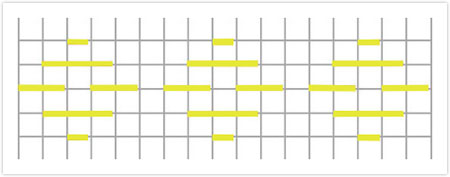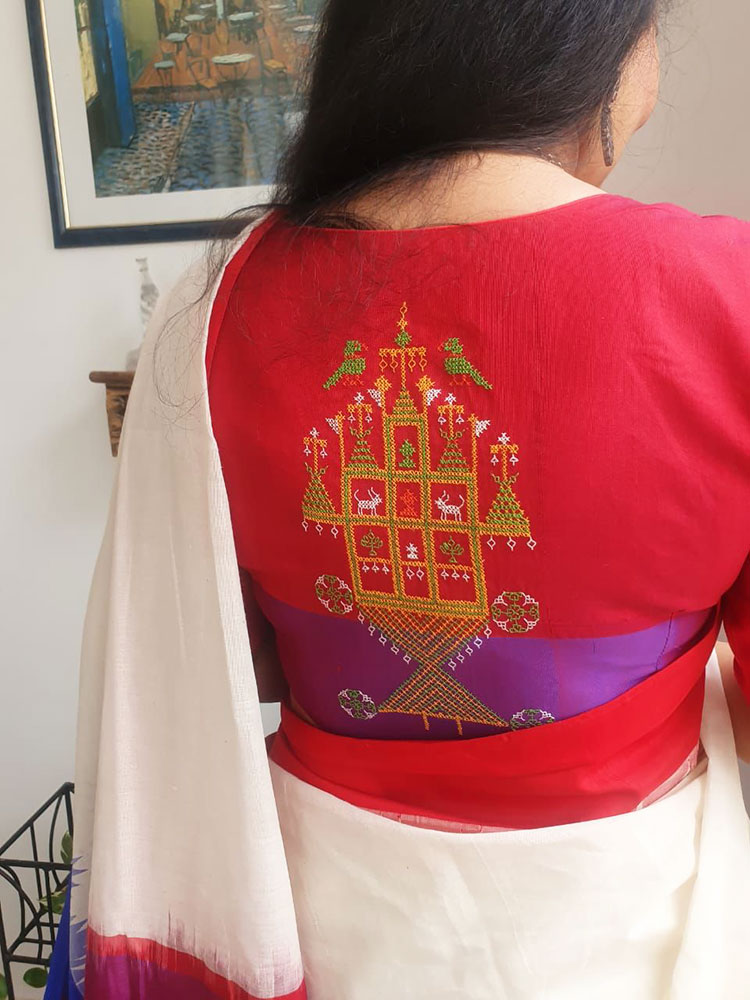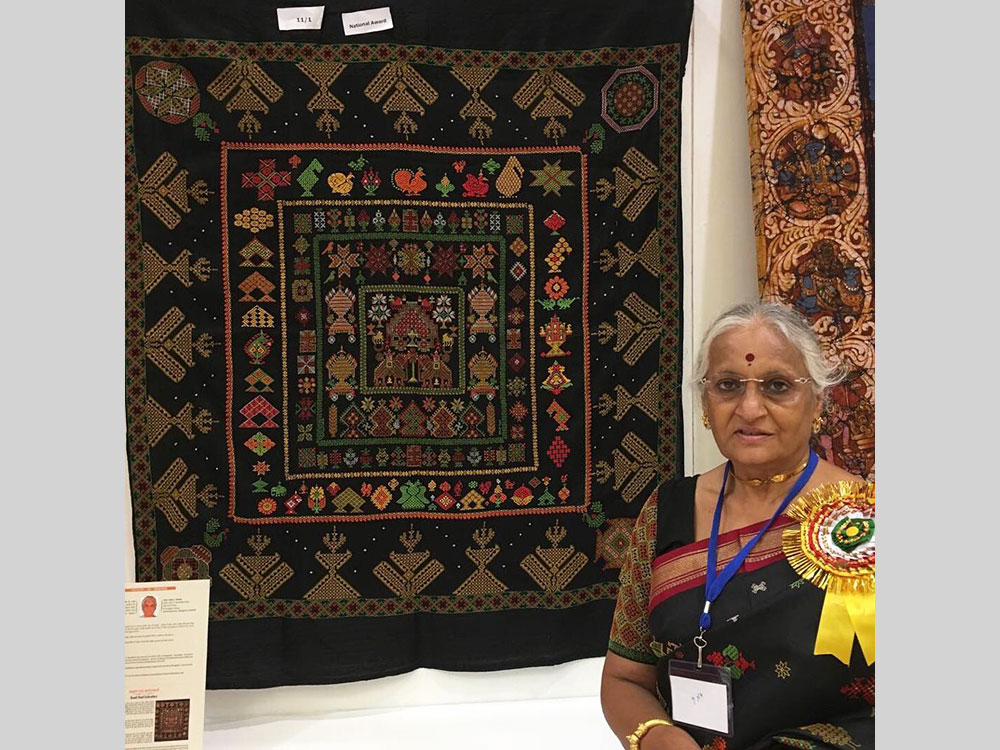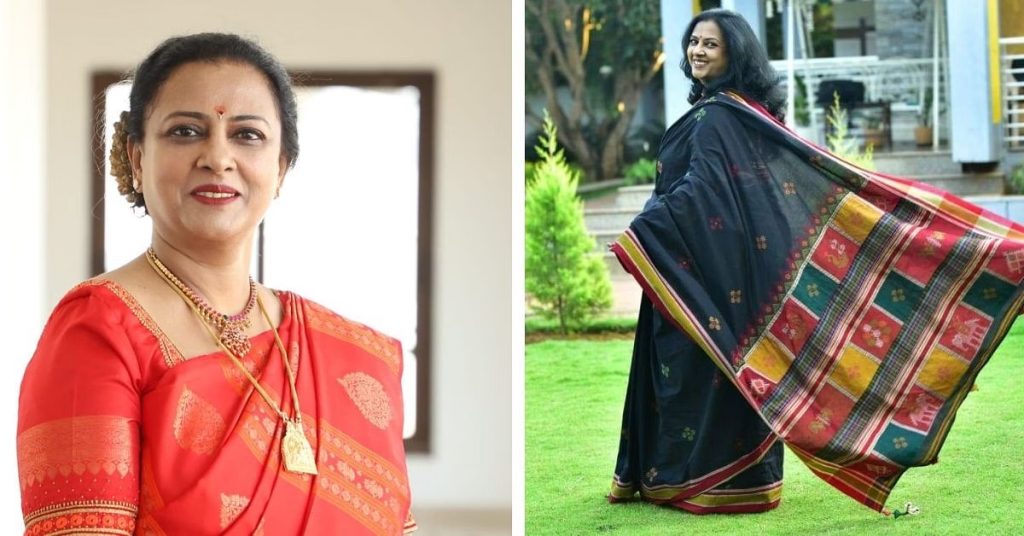The hands that embroider the Indian textiles are artists of the greatest degree. One such embroidery tradition from Karnataka is Kasuti embroidery. It is a popular art form in northern Karnataka that is practised by women of the region, India, rooted in the region’s villages. It is one of the oldest Indian practices, dating back to the 7th century A.D. Initially, it was exclusively done by women and remains a vital element of the cottage industry. The women embroiderers use cotton threads on handwoven textiles, with Bijapur, Dharwar, Belgaum, Miraj, Sangli, and Jamkhandi districts being famous for it.

The Ilkal sarees also made in Karnataka a few villages far also beautifully showcase this embroidery style in their sarees. In the past, a bride was expected to have a black silk sari, called Chandrakali sari, with Kasuti work. Kasuti embroidery is used on clothing items such as bonnets, capes, skirts, saris, bodices, and shawls. The government of India has provided a geographical indicator to safeguard the craftswomen who practise this art form and ensure profits return to them. Kasuti embroidery’s charm lies in its rich history, regional significance, and the skillful hands of women who continue this tradition.

Kasuti embroidery has always been a cherished domestic art form. In the past, it was customary to embroider Kasuti patterns on family clothing and give them to loved ones. Mothers would pass down their knowledge and train their daughters in this technique from a young age, ensuring the art’s continuity across generations. The intricate handiwork, vibrant colour combinations, and complex designs that machines have yet to replicate have garnered appreciation in foreign countries. Kasuti’s unique appeal has found favour beyond borders.
Designs and Kasuti Style
More than 5,000 stitches go into creating a pattern using a needle. Kasuti embroidery involves intricate patterns that require multiple artists to handle threads uniquely. Each thread is meticulously counted on the cloth, resulting in a complex and beautiful artwork. This traditional art form consists of four types of stitches: the gavanti stitch (double stitch), the muragi stitch (zig-zag stitch), the neygi stitch (darning stitch), and the hent stitch (cross-stitch). The meticulous counting and variety of stitches contribute to the unique and captivating look of Kasuti embroidery. The women of Karnataka are inspired by their surroundings and driven by religious, artistic, and domestic instincts and draw them out in their fabrics. Religious motifs such as temple Gopurams, ceremonial chariots and palanquins, lotus flowers, tulsi plant enclosures (tuisi katti), elephants with howdahs, peacocks with spread plumage, diverse birds, animals, and flowers. Additionally, everyday items such as cradles, anklet-bells, and palanquins are artistically represented. The embroidery done by women is typically done on handwoven dark-coloured fabric, often black in hue. The Kasuti embroidery features folk designs influenced by rangoli patterns of Karnataka.

Negi Stitch. Courtesy: Dsource.in
Colours, Materials of Kasuti Embroidery
A woman engaged in Kasuti embroidery, she carefully selects colours like red, purple, green, orange, and crimson. Rarely do the craftswomen work with patterns using only one or two colours; giving preference to vibrant combinations such as orange, green, and crimson or purple, green, orange, and red. Silk is the primary thread used in Kasuti embroidery, which is used to unpick from tassels on the pallu. However, nowadays, the women embroidering obtain silk commercially, employing various embroidery stitches like back stitch, running stitch, cross stitch, and zig-zag running stitch. Sometimes, the final effect resembles a woven design rather than typical embroidery. When stitching Kasuti, many horizontal, vertical, or diagonal stitches are employed, following a specific direction.

Contemporary Textiles with Kasuti Embroidery
Kasuti embroidery stands out not only for its zero-knot technique but also for the absence of traced designs on the fabric. Craftswomen create patterns from memory or as they embroider, counting threads meticulously. Kasuti extends beyond clothing and home décor, appearing on items like bags, purses, t-shirts, caps, and more. The contemporary adaptation of Kasuti has helped preserve the craft and provide economic opportunities. However, further efforts are needed to elevate the craft from its relatively obscure status. Kasuti embroidery is now applied to various textiles such as clothing, sarees, pillow coverings, door curtains, and tablecloths. Its production centres include Dharwar, Hubli, Kalghatgi, Gadag, and Mundargi.

Women artisans form a cooperative society supported by organisations like the regional handicraft Institute, Bhagini Samaj, and Janata Shikshana Samiti. This enables them to sustain a livelihood. A dedicated workforce of over 500 women, aged between 18 and 55, actively engages in the art of Kasuti embroidery.

Kasuti Embroidery Artist in Focus
Kasuti Embroidery is no simple task, one renowned artist who in her twilight years is still practising the beautiful artform is Smt. Usha J. Pawar. She is based in Bengaluru and has gained widespread recognition for her expertise in Kasuti embroidery. A recipient of the national award and serves as an inspiration to others. Initially learning the traditional embroidery techniques from her mother and aunts, she later received formal training from a dedicated teacher. Alongside her proficiency in various other embroidery styles, Smt. Usha devoted herself to mastering the famous Kasuti embroidery of Karnataka. For over 25 years, she has been teaching this art form, imparting her knowledge to women from diverse backgrounds and even foreigners. Some of the organisations she has worked with include Sumangli Seva Ashram, MEWS ladies club, and Karnataka State Co-operative Federation for Women. Smt. Usha actively participates in exhibitions and demonstrations, showcasing her skills and promoting this cherished craft. Such pioneers of the craft along with many nameless craftswomen are keeping the flame of Kasuti embroidery burning and inspiring many young entrepreneurs, designers and crafts persons to pick up the art of embroidering.

Latest in Kasuti News
In recent times one saw an Ilkal saree adorning Kasuti embroidery on Ms. Nirmala Sitharaman while she was presenting the Union budget for the year back in February 2023. The initiative which made that saree is Artikrafts by a textile connoisseur and lover of Indian crafts, Ms. Arati Hiremath. A revivalist who focuses upon Kasuti embroidery in her craft creations, her craft has gained traction since the day Ms. Sitharaman graced the public with her Kasuti. Keeping the 1,300 year old craft alive, the women artisans are empowered through this venture and creatively express themselves while embellishing sarees. Many such craft ventures, designers, initiatives are engaged in reviving this beautifully handcrafted art from Dharwad in Karnataka.


Contributor





